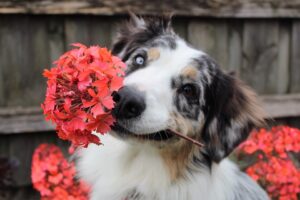Are Blue Daze Toxic to Dogs

A flowering evergreen that will brighten up your spring and summer garden is the ( Evolvulus glomerulus) or blue daze, this flowering beauty is native to Paraguay and Brazil. Blue daze is an evergreen and a member of the morning glory family. The common names of the blue daze are shaggy dwarf morning-glory or Hawaiian Blue Eye. Blue daze is a tropical plant that produces gray leaves which are fuzzy in appearance with bright blue flowers that bloom from mid-summer through mid-fall and can reach heights of 12 inches with a width of 2-3 ft. Blue daze grows well in zones 8-11.
We should always ensure before installing any garden plants to get a bit of history on those plants if they can exist in a garden where kids and animals play because many children, as well as animals, have been poisoned by consuming or ingesting the leaves. So the question is blue daze human and pet friendly?
Are Blue Daze Toxic to Dogs
According to research and study it’s “believed that Blue Daze is not a toxic plant and can be planted in the home garden.”
Signs of Plant Poisoning in Dogs
If these Symptoms Occur get to your Veternairn Right Away Don’t Delay.

- Seizures
- Breathing Difficulties
- Difficulties Swallowing
- Vomiting
- Drooling
- Tremors
- Diarrhea
- Pain
Signs of Plant Poisoning in Cats
If these Symptoms Occur get to your Veternairn Right Away Don’t Delay.

- Frequent Urination
- Drooling
- Excessive Drinking
- Overall Weakness
- Irregular Heatbeat
- Vomiting
- Breathing Difficulties
- Difficulties Swallowing
- Diarrhea
Additional Information
Even Children have been known to rush to the emergency room for consuming or ingesting plant parts, again before bringing any plants into your home or environment whether outdoor or indoor plants conduct research to ensure plant/plants are children and pet friendly.
Signs of Plant Poisoning in Children
If these Symptoms Occur get Medical Help Quickly Don’t Delay.
- Stomach Pain
- Vomiting
- Dizziness
- Headache
- Confusion
- Skin Poisoning includes Redness, Rash, Bumps, Weeping Blisters, Itching
In Case You Missed it here are other articles on the Blue Daze Plant
- Blue Daze Care
- Blue Daze Winter Care
- How to Grow Blue Daze Indoors
- Blue Daze Propagation In Water
- Blue My Mind Dwaf Morning Glory
- Blue Daze Ground Cover
- Blue Daze Hanging Basket
- Blue Daze Seeds
- Propagating Blue Daze
- Why Blue Daze is Not Blooming
- Why my Blue Daze Leaves are Turning Yellow
The final word on blue daze toxic to dogs
The blue daze flowering plant like every other garden plant should be given a history check before installing in your garden or indoor living space, many garden plants are beautiful with stunning foliage (leaves) and flowers however many of these plants though beautiful are harmful if consumed and can even cause death. So let’s make sure that before installing plants in our outdoor and indoor living space we do a history or a background check to ensure they are pet and children-friendly. Because what we want is not only a beautiful environment (garden plants) but an environment that is pet and human-friendly.
About the author
Norman loves being in the garden, both at home and for his job....
he is 'Natures Little helper' being outdoors, growing his vegetables and flowers from an early age.
Now having spent over 22 years in the profession he want to give some of his knowledge to others...
his vast array of hints and tips you will find scattered over this site will help you no end growing plants in your garden.

Hello Norman,
According to my understanding, your content provides important information on the potential toxicity of blue baze plants to dogs. This is valuable information for dog owners who may be unaware of the potential risks posed by certain plants.
And, it outlines the symptoms of blue baze toxicity in dogs and provides information on how to treat the symptoms. This can be valuable information for dog owners who may need to seek veterinary care for their pet.
As well as, it includes visuals of blue baze plants, which can help readers to identify the plant and avoid it if necessary.
And then, it targets prevention tips to help dog owners avoid blue baze toxicity, such as keeping the plant out of reach of pets and monitoring pets when they are outside.
Lastly, I mention, this is important because it provides valuable information on the potential toxicity of blue baze plants to dogs, as well as symptoms, treatment, and prevention tips. This information can help dog owners keep their pets safe and avoid potential health risks. The inclusion of visuals and prevention tips also adds to the post’s value as a resource for dog owners.
Thanks
SAM
Thanks so much for stopping by and commenting, before we install any plant in our garden or home we should get the history of those plants to avoid any danger that plants may present.
I like your topic. I think we have to know about these things and we should care more about the health of our pets. according to the ASPCA, blue daze (Evolvulus glomeratus) is not considered toxic to dogs. Nonetheless, it is still important to keep an eye on your pet and contact a veterinarian if you notice any unusual symptoms after they have consumed any plant material
Thank you so much, much thought should be given before we bring any plant into our outdoor or indoor living space to avoid any danger that might cause harm.